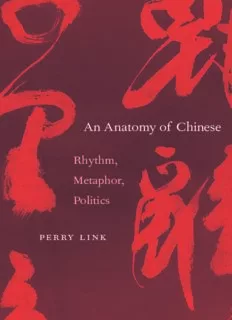
An Anatomy of Chinese: Rhythm, Metaphor, Politics PDF
Preview An Anatomy of Chinese: Rhythm, Metaphor, Politics
An Anatomy of Chinese Rhythm, Metaphor, Politics perry link An Anatomy of Chinese An Anatomy of Chinese Rhythm, Meta phor, Politics perry link harvard university press Cambridge, Massachusetts, and London, En gland 2013 Copyright © 2013 by the President and Fellows of Harvard College All rights reserved Printed in the United States of America Library of Congress Cataloging-i n-P ublication Data Link, E. Perry (Eugene Perry), 1944– An anatomy of Chinese : rhythm, meta phor, politics / Perry Link. p. cm. Includes bibliographical references and index. ISBN 978- 0-6 74-0 6602-1 (alk. paper) 1. Chinese language— Rhythm. 2. Chinese language— Metaphors. 3. Chinese language—T erms and phrases. 4. Chinese language—Semantics. 5. Chinese language— Political aspects. I. Title. PL1279.L483 2013 495.1'16—dc23 2012015096 To the sprightly spirit of Y. R. Chao— departed, and yet not— and to everyone else who loves the sounds and structures of spoken Chinese Contents Introduction 1 1 Rhythm 21 The Prevalence of Rhythmic Patterns in Daily- Life Chinese 24 Is Rhythm Unusually Common in Chinese? 37 Speakers’ Awareness of Rhythm 40 Are There Fads in Rhythms? 44 The Roots of Rhythms 49 “External” Rhythms: Dominant and Recessive 54 Recessive Rhythms of Favor 60 How Recessive Rhythms Affect Structure 68 How Universal Are the Preferred Rhythms of Chinese? 74 Do Rhythms Have Meanings? 82 What Other Formal Features Contribute to Meaning? 94 Can the Users of Rhythm Be Unaware of Its Effects? 109 2 Metap hor 113 How Do Metap hors Work in Ordinary Language? 115 viii Contents Meta phor and Thought 128 Time 136 Color 147 Up and Down 155 North and South 162 Consciousness 169 The Self in Ancient Thought 171 Privilege in Dyads 174 Meta phors That Chinese and Eng lish (Pretty Much) Share 183 Meta phors in Chinese That Diverge from Eng lish in Signifi cant Ways 198 Conceptual Differences That Are Rooted in Meta phor 209 Can Conceptual Metap hors Generate Philosophical Problems? 215 The Signifi cance of Similarities and Differences among Conceptual Meta phors in Different Languages 231 3 Politics 234 A Bifurcation 235 Characteristics of the Offi cial Language 243 The Language Game 278 How the Game Is Played: From the Side of the Rulers 295 How the Game Is Played: From the Side of the Ruled 321 Effects of the Language Game in the Mao and the Post- Mao Eras Compared 341 Epilogue 349 Ac knowl edgm ents 357 Index 359 Introduction This book has grown from fi les that I have kept for more than three de- cades on items that have fascinated me about the Chinese language. When I dug into those fi les a few years ago I found that, in order to inter- pret their contents responsibly, I would need to read in a number of fi elds— prosody, cognitive science, philosophy of mind, comparative poli- tics, even music theory— that were largely new to me. I asked colleagues for introductions to those fi elds and, with my store of Chinese examples serving as test cases, found the resulting exploration both pleas ur able and rewarding. Academic specialties in the early twenty-fi rst century bristle with their own jargons, and nearly every area I turned to required an investment of time before I felt I was getting what was there to be got. Each investment, in the end, was worthwhile. Special jargon does serve a purpose when it allows expression of thought that could not have been put as precisely in ordinary language. But that said, I should say as well that I often found the jargon of subfi elds to be not entirely necessary: the same thought could often have been put, just as clearly or more so, in plainer language. Why we academics like jargon is an important question. It relates to why many humanities and social science disciplines are becoming more self- contained, growing as if in parallel universes; why students can be puzzled as they move from economics to anthropology to literature, even if their teachers claim to be sharing a subject (“China,” for example); and why
Description: